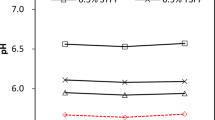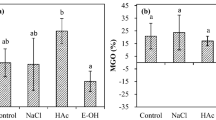Abstract
Dietary advanced glycation endproducts (AGEs), such as N ε-carboxymethyllysine (CML) and N ε-carboxyethyllysine (CEL), may promote aging and increase the risk for development of various chronic diseases. The effects of beef fat (8.3− 32.4 %), sodium nitrite (50 − 150 mg/kg) and sodium erythorbate (100 − 1000 mg/kg) contents on the formation of free and protein-bound AGEs including CML and CEL in ground beef during heating (100 °C, 0 − 60 min) were investigated. The proportion of free AGEs accounted for 1.1− 8.7 % of the sum of free and protein-bound AGEs, and decreased as the severity of the heat treatments increased. The amounts of free CML and CEL formed in ground beef (based upon protein weight) during heating were not affected by the levels of beef fat or sodium nitrite, but slightly decreased with the addition of 100 − 400 mg/kg erythorbate. The formation of protein-bound CML and CEL during heating was promoted with the addition of beef fat and erythorbate, but inhibited by nitrite. The overall effects of fat, nitrite and erythorbate on AGEs formation were relatively small compared to that of heat treatments. This study provides a greater understanding of the compositional factors involved in the formation of AGEs in complex foods during heating, which may help the optimization of thermal processes so that lower levels of AGEs are formed during food production operation.


Similar content being viewed by others
References
J. Uribarri, S. Woodruff, S. Goodman, W. Cai, X. Chen, R. Pyzik, A. Yong, G.E. Striker, H. Vlassara, Advanced glycation end products in foods and a practical guide to their reduction in the diet. J. Am. Diet. Assoc. 110, 911–916 (2010)
N. Ahmed, B. Mirshekar-Syahkal, L. Kennish, N. Karachalias, R. Babaei-Jadidi, P.J. Thornalley, Assay of advanced glycation endproducts in selected beverages and food by liquid chromatography with tandem mass spectrometric detection. Mol. Nutr. Food Res. 49, 691–699 (2005)
G.L.J. Hull, J.V. Woodside, J.M. Ames, G.J. Cuskelly, Nε-(carboxymethyl)lysine content of foods commonly consumed in a Western style diet. Food Chem. 131, 170–174 (2012)
X. Sun, J. Tang, J. Wang, B.A. Rasco, K. Lai, Y. Huang, Formation of advanced glycation endproducts in ground beef under pasteurisation conditions. Food Chem. 172, 802–807 (2015)
N. Rabbani, P.J. Thornalley, Glycation research in amino acids: a place to call home. Amino Acids 42, 1087–1096 (2012)
J.R. Fu, A.J. Requena, T.J. Jenkins, J.W. Lyons, S.R. Baynes, Thorpe, The advanced glycation end product, Nε-(carboxymethyl)lysine, is a product of both lipid peroxidation and glycoxidation reactions. J. Biol. Chem. 271, 9982–9986 (1996)
M. Lima, S.H. Assar, J.M. Ames, Formation of N-epsilon-(carboxymethyl) lysine and loss of lysine in casein glucose-fatty acid model systems. J. Agric. Food Chem. 58, 1954–1958 (2010)
S. Mildner-Szkudlarz, A. Siger, A. Szwengiel, J. Bajerska, Natural compounds from grape by-products enhance nutritive value and reduce formation of CML in model muffins. Food Chem. 172, 78–85 (2015)
C. Srey, G.L.J. Hull, L. Connolly, C.T. Elliott, M.D. del Castillo, J.M. Ames, Effect of inhibitor compounds on Nε-(carboxymethyl)lysine (CML) and Nε-(carboxyethyl)lysine (CEL) formation in model foods. J. Agric. Food Chem. 58, 12036–12041 (2010)
K.-O. Honikel, The use and control of nitrate and nitrite for the processing of meat products. Meat Sci. 78, 68–76 (2008)
K. Lee, J.E. Shimaoka, Forms of iron in meats cured with nitrite and erythorbate. J. Food Sci. 49, 284–285 (1984)
J.S. Douglass, F.D. Morrow, K. Ono, J.T. Keeton, J.T. Vanderslice, R.C. Post, B.W. Willis, Impact of sodium ascorbate and sodium erythorbate used in meat processing on the Vitamin-B12 contents of cured ham. J. Food Sci. 54, 1473–1474 (1989)
R.A. Mancini, M.C. Hunt, M. Seyfert, D.H. Kropf, K.A. Hachmeister, T.J. Herald, D.E. Johnson, Comparison of ascorbic acid and sodium erythorbate: effects on the 24 h display colour of beef lumbar vertebrae and longissimus lumborum packaged in high-oxygen modified atmospheres. Meat Sci. 75, 39–43 (2007)
B.S. Fleenor, A.L. Sindler, J.S. Eng, N.P. Nair, R.B. Dodson, D.R. Seals, Sodium nitrite de-stiffening of large elastic arteries with aging: role of normalization of advanced glycation end-products. Exp. Gerontol. 47, 588–594 (2012)
J.A. Vinson, T.B. Howard, Inhibition of protein glycation and advanced glycation end products by ascorbic acid and other vitamins and nutrients. J. Nutr. Biochem. 7, 659–663 (1996)
L. Li, L. Han, Q. Fu, Y. Li, Z. Liang, J. Su, B. Li, Formation and inhibition of Nε-(carboxymethyl)lysine in saccharide-lysine model systems during microwave heating. Molecules 17, 12758–12770 (2012)
J.A. Dunn, M.U. Ahmed, M.H. Murtiashaw, J.M. Richardson, M.D. Walla, S.R. Thorpe, J.W. Baynes, Reaction of ascorbate with lysine and protein under autoxidizing conditions: formation of Nε-(carboxymethyl)lysine by reaction between lysine and products of autoxidation of ascorbate. Biochemistry 29, 10964–10970 (1990)
M.U. Ahmed, E. Brinkmann Frye, T.P. Degenhardt, S.R. Thorpe, J.W. Baynes, Nε-(carboxyethyl)lysine, a product of the chemical modification of proteins by methylglyoxal, increases with age in human lens proteins. Biochem. J 324, 565–570 (1997)
G. Zhang, G. Huang, L. Xiao, A.E. Mitchell, Determination of advanced glycation endproducts by LC-MS/MS in raw and roasted almonds (Prunusdulcis). J. Agri. Food Chem. 59, 12037–12046 (2011)
J.L.J.M. Scheijen, E. Clevers, L. Engelen, P.C. Dagnelie, F. Brouns, C.D.A. Stehouwer, C.G. Schalkwijk, Analysis of advanced glycation endproducts in selected food items by ultra-performance liquid chromatography tandem mass spectrometry: presentation of a dietary AGE database. Food Chem. 190, 1145–1150 (2016)
J. Lawrence. Meat and meat Products AOAC Official Method 950.46. Moisture in meat; Method 991.36. Fat (crude) in meat and meat Products Solvent extraction (submersion) method; Method 928.08. Nitrogen in meat. Kjeldahl method. in Official Methods of Analysis of AOAC International, ed. by W. Horwitz, G.W. Latimer (AOAC international, Arlington, 2005) Chap. 39, pp. 1–6.
F. Kong, J. Tang, B. Rasco, C. Crapo, S. Smiley, Quality changes of salmon(Oncorhynchus gorbuscha) muscle during thermal processing. J. Food Sci. 72, 103–111 (2007)
X. Sun, J. Tang, J. Wang, B.A. Rasco, K. Lai, Y. Huang, Formation of free and protein-bound carboxymethyllysine and carboxyethyllysine in meats during commercial sterilization. Meat Sci. 116, 1–7 (2016)
S.H. Assar, C. Moloney, M. Lima, R. Magee, J.M. Ames, Determination of Nε-(carboxymethyl)lysine in food systems by ultra performance liquid chromatography-mass spectrometry. Amino Acids 36, 317–326 (2009)
C. Niquet-Léridon, F.J. Tessier, Quantification of Nε-carboxymethyl-lysine in selected chocolate-flavoured drink mixes using high-performance liquid chromatography-linear ion trap tandem mass spectrometry. Food Chem. 126, 655–663 (2011)
P.A. Morrissey, J.Z. Tichivangana, The antioxidant activities of nitrite and nitrosylmyoglobin in cooked meats. Meat Sci. 14, 175–190 (1985)
M. Kröger-Ohlsen, L.H. Skibsted, Kinetics and mechanism of reduction of ferrylmyoglobin by ascorbate and D-isoascorbate. J. Agric. Food Chem. 45, 668–676 (1997)
L. Ramanathan, N.P. Das, Effect of natural copper chelating compounds on the pro-oxidant activity of ascorbic acid in steam-cooked ground beef. Int. J. Food Sci. Technol. 28, 279–288 (1993)
J. Du, J.J. Cullen, G.R. Buettner, Ascorbic acid: chemistry, biology and the treatment of cancer. Biochim. Biophys. Acta 1826, 443–457 (2012)
A. Frolov, R. Schmidt, S. Spiller, U. Greifenhagen, R. Hoffmann, Arginine-derived advanced glycation end products generated in peptide – glucose mixtures during boiling. J. Agric. Food Chem. 62, 3626–3635 (2014)
M. Smuda, M.A. Glomb, Maillard degradation pathways of vitamin C. Angew. Chem. 52, 4887–4891 (2013)
Acknowledgments
This study was funded by the USDA-NIFA 2011-68003-20096, Shanghai Ocean University (A1-0209-14-0902-2) and the Washington State University Agricultural Research Center.
Author information
Authors and Affiliations
Corresponding authors
Rights and permissions
About this article
Cite this article
Sun, X., Tang, J., Wang, J. et al. Formation of N ε-carboxymethyllysine and N ε-carboxyethyllysine in ground beef during heating as affected by fat, nitrite and erythorbate. Food Measure 11, 320–328 (2017). https://doi.org/10.1007/s11694-016-9400-6
Received:
Accepted:
Published:
Issue Date:
DOI: https://doi.org/10.1007/s11694-016-9400-6




